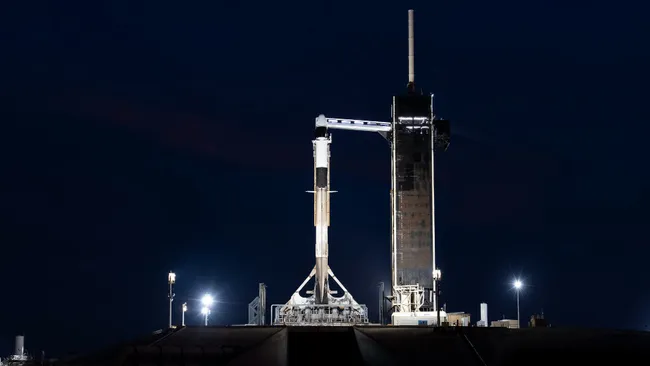SpaceX Crew Dragon is in orbit for a long-awaited private astronaut mission that will perform the first commercial spacewalk and reach higher than any crewed mission in more than 50 years. The Falcon 9 lifted off from Kennedy Space Center’s Launch Complex 39A at 5:23 a.m. on Sept. 10 as part of the Polaris Dawn mission. Controllers used the second of three launch opportunities available early this morning after poor weather forced them to abandon the first launch attempt about two hours earlier.
Crew Dragon separated from the Falcon 9 upper stage about 12 minutes after liftoff. The mission was aiming for an initial orbit of about 190 by 1,200 kilometers, but SpaceX did not immediately release details on the orbit reached during the launch.
After about eight revolutions, Dragon will raise its apogee to 1,400 kilometers (980 miles) over the next six orbits, the highest altitude for a crewed mission since Apollo 17’s December 1972 moon mission. It will then lower its apogee to 430 miles (700 kilometers). The mission’s most important moment will come on the third day of the flight, Sept. 12. A crew of four, wearing new extravehicular activity (EVA) suits developed by SpaceX, will depressurize the Crew Dragon cabin. Two of the four, Commander Jared Isaacman and Mission Specialist Sarah Gillis, will exit separately through a hatch in the nose of Dragon for about 15 to 20 minutes each, performing the first spacewalks on a nongovernment mission.
“Eva is probably the biggest piece of Polaris Dawn’s development,” Isaacman said of the riskiest mission at a press conference on Aug. 19. “You’re throwing away all the security of your car. Your suit becomes your spaceship.”
Once in space, the Polaris Dawn crew, including pilot Kidd Poteet and mission specialist Anna Menon, will test intersatellite laser communications between Crew Dragon and SpaceX’s Starlink constellation, as well as conduct about 40 experiments related to human health and related topics. The mission will conclude with a landing off the coast of Florida on September 15, the sixth day of the flight.
Isaacman, who previously led and funded the Inspiration4 private astronaut mission that launched aboard another Crew Dragon almost exactly three years ago, announced the Polaris private astronaut mission program in February 2022. At the time, they envisioned a Polaris Dawn flight in late 2022.
But that schedule was cut back significantly, largely because of work on the EVA suits. “When we first started, we would come to training every day, and pretty much every day we would come in, we had a different suit,” Gillis recalled at a press conference, as engineers adjusted the suit’s various components.
Isaacman told the briefing that the initial schedule was ambitious. “If the original deadline was nine months, I think you would all be wondering how we were able to work so fast,” he said, but added that this was the motivation for the project. “I think it was fair to say at the outset that we were going to try to get there at lightning speed.”
Both the Polaris Dawn team and SpaceX officials were finally confident they were ready to fly. “EVA is a risky adventure, but we’ve made all the preparations,” Bill Gerstenmaier, SpaceX’s vice president of assembly and flight reliability and former NASA associate administrator for human space flight, said at a briefing. “I think it’s a real credit to this team that they’ve pushed the technology forward, and we’re going to do it as safely as possible.”
Prior to launch, Polaris Dawn experienced another delay. The mission’s launch, scheduled for August 26, was postponed one day to allow extra time to prepare the spacecraft and another day to fix a helium leak on the ground side of the quick-detachable umbilical. Weather then intervened, with persistently bad weather forecast for high-tide areas.
“Our launch criteria are heavily constrained by the forecast weather conditions for the tides. With no approach point to the ISS and limited life support supplies, we need to be absolutely certain of the weather conditions for re-entry before we launch,” Isaacman said when SpaceX first announced the weather delays on Aug. 27. Those delays lasted about two weeks before the forecast improved enough to attempt a launch.
The mission also needed to launch by the end of the week or face further delays, possibly into October, so SpaceX could prepare LC-39A for NASA’s Europa Clipper launch aboard the Falcon Heavy on Oct. 10. That mission has a three-week launch window.
Polaris Dawn is planned to be the first of three missions in the overall Polaris program and will culminate in the first crewed launch of SpaceX’s Starship. The program has not provided a timeline for that mission or the second Crew Dragon mission, which Isaacman said will be built on Polaris Dawn in an undisclosed manner. Isaacman, founder and CEO of the $1.8 billion payment processing company Shift4, declined to say how much he spent on the Polaris Dawn mission at a press conference.













